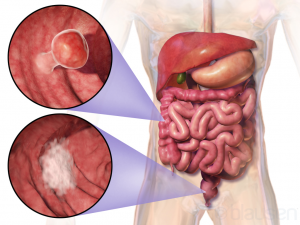- Home
- Editorial
- News
- Practice Guidelines
- Anesthesiology Guidelines
- Cancer Guidelines
- Cardiac Sciences Guidelines
- Critical Care Guidelines
- Dentistry Guidelines
- Dermatology Guidelines
- Diabetes and Endo Guidelines
- Diagnostics Guidelines
- ENT Guidelines
- Featured Practice Guidelines
- Gastroenterology Guidelines
- Geriatrics Guidelines
- Medicine Guidelines
- Nephrology Guidelines
- Neurosciences Guidelines
- Obs and Gynae Guidelines
- Ophthalmology Guidelines
- Orthopaedics Guidelines
- Paediatrics Guidelines
- Psychiatry Guidelines
- Pulmonology Guidelines
- Radiology Guidelines
- Surgery Guidelines
- Urology Guidelines
Right-sided colorectal tumors: An internal radiation advantage

For patients with colorectal cancer that has metastasized to the liver, having a primary tumour on the left side, as opposed to the right side of the colon, is known to be a significant advantage in terms of treatment response.
But now a new study, presented here at the ESMO 19th World Congress on Gastrointestinal Cancer, suggests this imbalance may be at least partially redressed.
Reversing the usual pattern, patients whose liver metastases had spread from right-sided primary tumours (RSP) had a 36% better survival rate after treatment with a combination of first-line chemotherapy and selective internal radiation therapy (SIRT) using Y-90 resin microspheres, compared to chemotherapy alone, according to the study.
This same treatment combination was no better than chemotherapy only in patients with left-sided primary tumours (LSP).
"These findings are good news for patients with right-sided primary tumours, who have a much worse prognosis and fewer treatment options than patients with left-sided tumours," said study investigator Guy van Hazel, MD, from the University of Western Australia in Perth, Australia.
"We are excited because hitherto no treatment apart from the addition of bevacizumab to chemotherapy has improved the dismal outcome of liver metastases coming from right-sided primary tumours."
The analysis included 739 patients from two completed studies called SIRFLOX (SF) and FOXFIRE-Global (FFG).
All patients had liver-only or liver-dominant metastatic colorectal cancer (mCRC), and had been randomised to receive either standard chemotherapy alone, or combined with SIRT. The chemotherapy regimen was mFOLFOX6, and most patients received bevacizumab as well.
Information on the patients' primary tumour location was recorded at the start, with 24% having right-sided and 73% left-sided disease (the remaining 3% had primary tumours on both sides of the colon, or the primary tumour site was unknown).
Overall, outcomes were not different between the chemotherapy alone and chemotherapy plus SIRT groups, with median overall survival (OS) and progression-free survival (PFS) around 24 months and 11 months, respectively.
However, when the investigators examined patients with RSP and LSP separately they saw a clear difference.
Patients with liver metastases from RSP had significantly better OS when SIRT was added to their chemotherapy compared to those who had chemotherapy alone (22.0 vs. 17.1 months, respectively; p=0.007; Hazard Ratio [HR]: 0.64 [95% CI: 0.46-0.89]), but this was not the case for patients with LSP (24.6 vs. 25.6 months; p=0.279; HR: 1.12 [0.92-1.36]).
"That means that RSP patients treated with chemotherapy plus SIRT have a 36% reduced risk of dying at any time point," said van Hazel.
There was also a 27% improvement in PFS, although this was not statistically significant.
"This is the first time that location of primary tumour has been linked to radiation therapy," said van Hazel, and although it's possible that it may only apply to patients receiving first-line therapy, he said it opens a new treatment option for these patients.
There were no differences in side effects between patients with RSP and LSP tumours, and although patients who had both chemotherapy and SIRT did experience more side-effects than those who had chemotherapy alone, these were "predictable and manageable," said van Hazel.
Commenting on the study, ESMO spokespersons Dirk Arnold, from Instituto CUF de Oncologia in Lisbon, Portugal and Eric Van Cutsem, University Hospitals Leuven, Belgium, said that these findings contribute to the recent debates on both the biological heterogeneity of colon cancers and tumour localisation.
"It remains to be confirmed whether these results mean that right-sided tumours are more sensitive to this kind of radiotherapy - or whether this is simply related to the fact that the molecular characteristics of right-sided tumours allow less treatment options, because they have more mutations," they explained. "Additionally the well-known worse prognosis of right-sided tumours increases the relative importance of a non-systemic treatment option. More data on the molecular factors determining these results are warranted."

Disclaimer: This site is primarily intended for healthcare professionals. Any content/information on this website does not replace the advice of medical and/or health professionals and should not be construed as medical/diagnostic advice/endorsement or prescription. Use of this site is subject to our terms of use, privacy policy, advertisement policy. © 2020 Minerva Medical Treatment Pvt Ltd